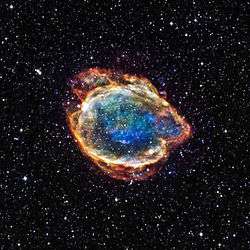Kilonova
A kilonova (also called a ‘macronova’ or an ‘r-process supernova’) occurs when two neutron stars or a neutron star and a black hole merge in a binary system. Strong electromagnetic radiation is emitted due to the decay of heavy r-process ions that are produced and ejected fairly isotropically during the merger process—similar to a faint, short-lived supernova.[1] The inspiral and merging of two compact objects are thought to be a strong source of gravitational waves (GWs).[2][3] It is also thought to be the progenitor of short gamma-ray bursts[2][3] and the predominant source of stable r-process elements in the Universe.[1]
The first clear detection of a kilonova was in association with the short-duration gamma-ray burst GRB 130603B. This gamma-ray burst was in a relatively nearby galaxy, enabling the faint infra-red emission from the kilonova to be detected using the Hubble Space Telescope.
See also
References
- 1 2 Tanvir, N. R.; Levan, A. J.; Fruchter, A. S.; Hjorth, J.; Hounsell, R. A.; Wiersema, K.; Tunnicliffe, R. L. (2013). "A 'kilonova' associated with the short-duration γ-ray burst GRB 130603B". Nature. 500 (7464): 547–9. arXiv:1306.4971
 . Bibcode:2013Natur.500..547T. doi:10.1038/nature12505. PMID 23912055.
. Bibcode:2013Natur.500..547T. doi:10.1038/nature12505. PMID 23912055. - 1 2 Metzger, B. D.; Martínez-Pinedo, G.; Darbha, S.; Quataert, E.; et al. (August 2010). "Electromagnetic counterparts of compact object mergers powered by the radioactive decay of r-process nuclei". Monthly Notices of the Royal Astronomical Society. 406 (4): 2650. arXiv:1001.5029
 . Bibcode:2010MNRAS.406.2650M. doi:10.1111/j.1365-2966.2010.16864.x.
. Bibcode:2010MNRAS.406.2650M. doi:10.1111/j.1365-2966.2010.16864.x. - 1 2 Nicole Gugliucci (7 August 2013). "Kilonova Alert! Hubble Solves Gamma Ray Burst Mystery". news.discovery.com. Discovery Communications. Retrieved 22 January 2015.

